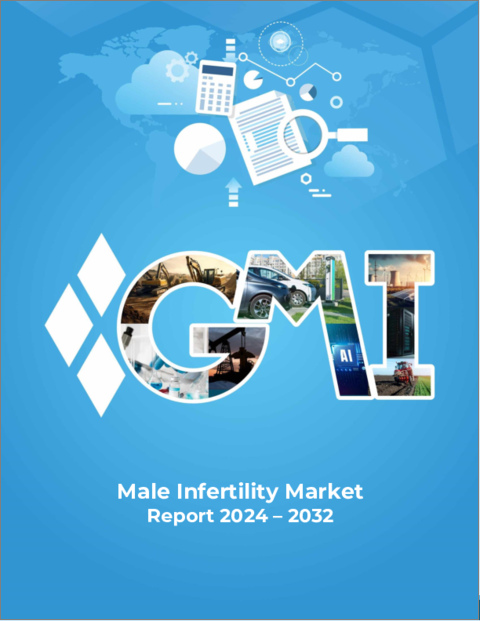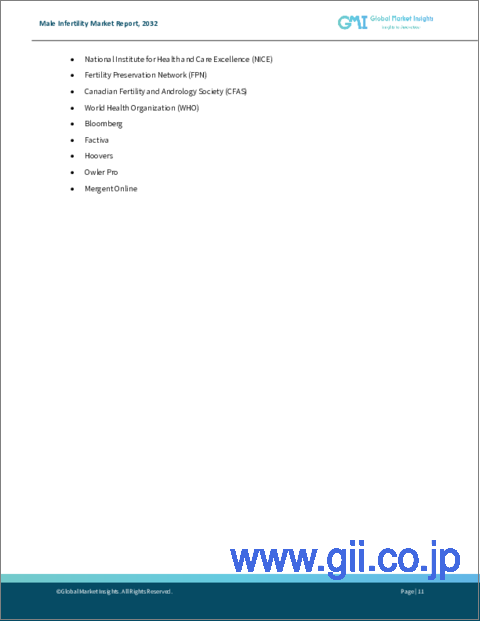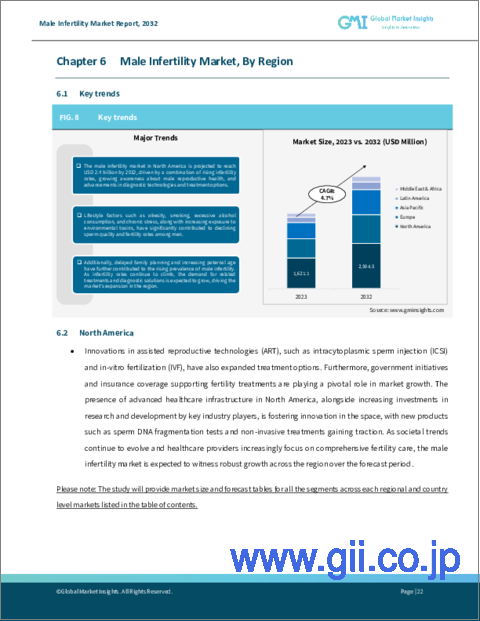|
|
市場調査レポート
商品コード
1568639
男性不妊症の世界市場:機会、成長促進要因、産業動向分析、予測(2024年~2032年)Male Infertility Market, Opportunity, Growth Drivers, Industry Trend Analysis and Forecast, 2024-2032 |
||||||
カスタマイズ可能
|
|||||||
| 男性不妊症の世界市場:機会、成長促進要因、産業動向分析、予測(2024年~2032年) |
|
出版日: 2024年07月29日
発行: Global Market Insights Inc.
ページ情報: 英文 115 Pages
納期: 2~3営業日
|
全表示
- 概要
- 目次
世界の男性不妊症の市場規模は、2024年~2032年に4.7%のCAGRを示すと予測されます。
不妊症は世界的に関心が高まっており、全世界のカップルの15%が罹患していると推定されています。世界保健機関(WHO)によると、男性不妊症はその半数近くを占めており、効果的な治療ソリューションに対する需要が急増しています。
男性不妊問題に対する意識の高まりは、診断技術や治療法の進歩と相まって、市場拡大を促進すると予想されます。さらに、晩婚化への社会的なシフトと不妊治療に対する受容の高まりが、男性不妊治療ソリューションの需要をさらに押し上げています。
治療分野は、薬物療法、外科的介入、生殖補助医療(ART)など、さまざまな治療オプションが利用できるようになったことが原動力となり、2024~2032年にかけて大きな成長を遂げると思われます。なかでも、卵細胞質内精子注入法(ICSI)や体外受精(IVF)などのARTは、その成功率の高さから導入が増加しています。ホルモン療法や遺伝子編集技術などの革新的な治療法の開発も、この分野の成長に寄与しています。不妊症の課題を克服するための解決策を求める男性が増えるにつれて、治療分野は市場で大きなシェアを占めると予想されます。
オンライン薬局は、2032年までに男性不妊症市場で注目すべきシェアを獲得すると見られています。eコマース・プラットフォームの普及とデジタル健康相談の増加傾向により、患者は自宅に居ながらにして不妊治療や薬にアクセスしやすくなっています。オンライン薬局は、幅広い不妊治療製品を、多くの場合、競合価格で提供しており、さらに宅配サービスという利点もあります。このようなオンライン購入へのシフトは、不妊治療専門クリニックへのアクセスが限られている地域では特に重要であり、患者に不妊治療を管理するための信頼できる利用しやすい選択肢を提供しています。
欧州は、高度なヘルスケア・インフラ、高い認知度、政府の支援策により、2024年~2032年にかけて男性不妊症市場で顕著な成長を遂げると思われます。この地域は生殖医療に力を入れており、研究開発への多額の投資と相まって、不妊治療の技術革新を促進しています。さらに、欧州には主要な製薬企業や不妊治療クリニックが存在するため、最先端の治療が広く利用できるようになっています。不妊の問題で医療支援を求める男性の数が増加していることから、欧州市場は、良好な規制環境と地域全体で不妊治療が受け入れられつつあることに支えられ、大幅な成長を遂げるものと思われます。
目次
第1章 調査手法と調査範囲
第2章 エグゼクティブサマリー
第3章 業界洞察
- エコシステム分析
- 業界への影響要因
- 促進要因
- 診断技術の進歩
- 生殖補助医療技術の成長
- 不妊治療の研究開発の増加
- 意識の高まりと教育
- 業界の潜在的リスクと課題
- 高額な治療費
- 副作用と合併症
- 促進要因
- 成長可能性分析
- 規制状況
- 技術的展望
- コア技術
- 隣接技術
- 価格分析(2023年)
- 今後の市場動向
- ポーターの分析
- PESTEL分析
第4章 競合情勢
- イントロダクション
- 企業シェア分析
- 企業マトリックス分析
- 主要市場企業の競合分析
- 競合のポジショニングマトリックス
- 戦略ダッシュボード
第5章 市場推計・予測:タイプ別(2021年~2032年)
- 主要動向
- 検査
- DNA断片化技術
- 酸化ストレス分析
- 顕微鏡検査
- 精子凝集
- コンピューター支援精液分析
- 精子侵入アッセイ
- その他の検査
- 治療
- 薬物療法
- ARTおよび精索静脈瘤手術用試薬・キット
第6章 市場推計・予測:流通チャネル別(2021年~2032年)
- 主要動向
- 院内薬局
- 小売薬局およびドラッグストア
- オンライン薬局
第7章 市場推計・予測:地域別(2021年~2032年)
- 主要動向
- 北米
- 米国
- カナダ
- 欧州
- ドイツ
- 英国
- フランス
- スペイン
- イタリア
- オランダ
- その他欧州
- アジア太平洋
- 中国
- 日本
- インド
- オーストラリア
- 韓国
- その他アジア太平洋
- ラテンアメリカ
- ブラジル
- メキシコ
- アルゼンチン
- その他ラテンアメリカ
- 中東・アフリカ
- 南アフリカ
- サウジアラビア
- アラブ首長国連邦
- その他中東・アフリカ
第8章 企業プロファイル
- Andrology Solutions
- ASKA Pharmaceutical Co., Ltd.
- AdvaCare Pharma
- Bayer AG
- CinnaGen Co.
- CaerusBiotech
- Endo International plc
- HalotechDNA
- Intas Pharmaceuticals Ltd.
- Merck KGaA
- Sanofi
- SCSA Diagnostics, Inc
- The Cooper Companies, Inc.
- Vitrolife Group
- Zydus Lifesciences Limited
The Global Male Infertility Market is poised to exhibit 4.7% CAGR from 2024 to 2032, driven by increasing awareness and access to advanced treatment options. Infertility is a growing concern worldwide, affecting an estimated 15% of couples globally. According to the World Health Organization (WHO), male infertility contributes to nearly half of these cases, leading to a surge in demand for effective treatment solutions.
The rising awareness of male infertility issues, coupled with advancements in diagnostic techniques and treatment methods, is expected to propel market expansion. Additionally, societal shifts towards later parenting and the growing acceptance of fertility treatments are further bolstering the demand for male infertility solutions.
The overall Male Infertility Industry is classified based on the test, distribution channel, and region.
The treatment segment will experience significant growth over 2024-2032, driven by the availability of various therapeutic options, including medications, surgical interventions, and assisted reproductive technologies (ART). Among these, ART procedures such as intracytoplasmic sperm injection (ICSI) and in vitro fertilization (IVF) are witnessing increasing adoption due to their high success rates. The development of innovative treatments, such as hormonal therapies and gene editing techniques, is also contributing to the growth of this segment. As more men seek solutions to overcome infertility challenges, the treatment segment is expected to capture a substantial share of the market.
Online pharmacies are set to gain a notable share in the Male Infertility Market by 2032, driven by the increasing preference for convenient and discreet purchasing options. The proliferation of e-commerce platforms and the growing trend of digital health consultations are making it easier for patients to access fertility treatments and medications from the comfort of their homes. Online pharmacies offer a wide range of fertility products, often at competitive prices, along with the added benefit of home delivery services. This shift towards online purchasing is particularly significant in regions with limited access to specialized fertility clinics, providing patients with a reliable and accessible option for managing their infertility treatment.
Europe will drive commendable gains in the Male Infertility Market throughout 2024-2032, owing to its advanced healthcare infrastructure, high awareness levels, and supportive government initiatives. The region's strong focus on reproductive health, coupled with significant investment in research and development, is fostering innovation in infertility treatments. Additionally, the presence of leading pharmaceutical companies and fertility clinics in Europe is contributing to the widespread availability of cutting-edge treatments. With a growing number of men seeking medical assistance for infertility issues, the European market is set to experience substantial growth, supported by favorable regulatory environments and increasing acceptance of fertility treatments across the region.
Table of Contents
Chapter 1 Methodology and Scope
- 1.1 Market scope and definitions
- 1.2 Research design
- 1.2.1 Research approach
- 1.2.2 Data collection methods
- 1.3 Base estimates and calculations
- 1.3.1 Base year calculation
- 1.3.2 Key trends for market estimation
- 1.4 Forecast model
- 1.5 Primary research and validation
- 1.5.1 Primary sources
- 1.5.2 Data mining sources
Chapter 2 Executive Summary
- 2.1 Industry 360° synopsis
Chapter 3 Industry Insights
- 3.1 Industry ecosystem analysis
- 3.2 Industry impact forces
- 3.2.1 Growth drivers
- 3.2.1.1 Advancements in diagnostic technologies
- 3.2.1.2 Growth in assisted reproductive technologies
- 3.2.1.3 Increasing research and development in fertility treatments
- 3.2.1.4 Rising awareness and education
- 3.2.2 Industry pitfalls and challenges
- 3.2.2.1 High cost of treatment
- 3.2.2.2 Side effects and complications
- 3.2.1 Growth drivers
- 3.3 Growth potential analysis
- 3.4 Regulatory landscape
- 3.5 Technological landscape
- 3.5.1 Core technologies
- 3.5.2 Adjacent technologies
- 3.6 Pricing analysis, 2023
- 3.7 Future market trends
- 3.8 Porter's analysis
- 3.9 PESTEL analysis
Chapter 4 Competitive Landscape, 2023
- 4.1 Introduction
- 4.2 Company market share analysis
- 4.3 Company matrix analysis
- 4.4 Competitive analysis of major market players
- 4.5 Competitive positioning matrix
- 4.6 Strategy dashboard
Chapter 5 Market Estimates and Forecast, By Type, 2021 - 2032 ($ Mn)
- 5.1 Key trends
- 5.2 Test
- 5.2.1 DNA fragmentation technique
- 5.2.2 Oxidative stress analysis
- 5.2.3 Microscopic examination
- 5.2.4 Sperm agglutination
- 5.2.5 Computer assisted semen analysis
- 5.2.6 Sperm penetration assay
- 5.2.7 Other tests
- 5.3 Treatment
- 5.3.1 Medication
- 5.3.2 ART and varicocele surgery reagents and kits
Chapter 6 Market Estimates and Forecast, By Distribution Channel, 2021 - 2032 ($ Mn)
- 6.1 Key trends
- 6.2 Hospitals pharmacies
- 6.3 Retail pharmacies and drug stores
- 6.4 Online pharmacies
Chapter 7 Market Estimates and Forecast, By Region, 2021 - 2032 ($ Mn)
- 7.1 Key trends
- 7.2 North America
- 7.2.1 U.S.
- 7.2.2 Canada
- 7.3 Europe
- 7.3.1 Germany
- 7.3.2 UK
- 7.3.3 France
- 7.3.4 Spain
- 7.3.5 Italy
- 7.3.6 Netherlands
- 7.3.7 Rest of Europe
- 7.4 Asia Pacific
- 7.4.1 China
- 7.4.2 Japan
- 7.4.3 India
- 7.4.4 Australia
- 7.4.5 South Korea
- 7.4.6 Rest of Asia Pacific
- 7.5 Latin America
- 7.5.1 Brazil
- 7.5.2 Mexico
- 7.5.3 Argentina
- 7.5.4 Rest of Latin America
- 7.6 Middle East and Africa
- 7.6.1 South Africa
- 7.6.2 Saudi Arabia
- 7.6.3 UAE
- 7.6.4 Rest of Middle East and Africa
Chapter 8 Company Profiles
- 8.1 Andrology Solutions
- 8.2 ASKA Pharmaceutical Co., Ltd.
- 8.3 AdvaCare Pharma
- 8.4 Bayer AG
- 8.5 CinnaGen Co.
- 8.6 CaerusBiotech
- 8.7 Endo International plc
- 8.8 HalotechDNA
- 8.9 Intas Pharmaceuticals Ltd.
- 8.10 Merck KGaA
- 8.11 Sanofi
- 8.12 SCSA Diagnostics, Inc
- 8.13 The Cooper Companies, Inc.
- 8.14 Vitrolife Group
- 8.15 Zydus Lifesciences Limited






